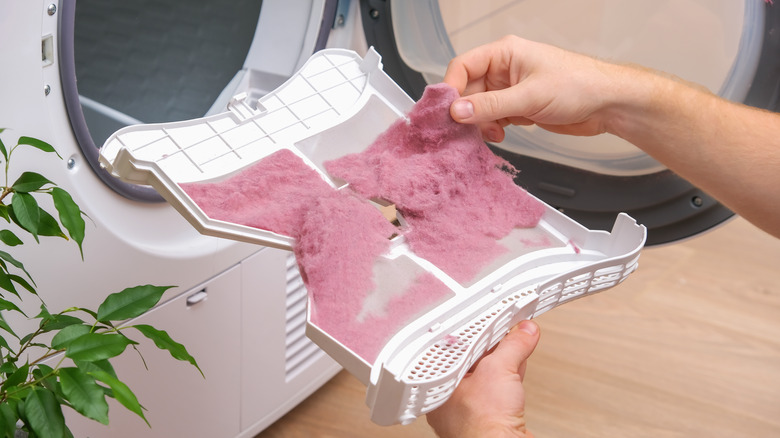Easily Clean Out Dryer Lint With This Swiffer Hack
Lint is one of the necessary evils of laundry. If you use your dryer, you will always have buildup in the trap, no matter what you do. That's because lint is created when fabrics lose tiny fibers when washed or dried. The excessive spinning and tumbling make them shed, and the lint trap captures them. It's unavoidable, so you're stuck cleaning the lint trap every time you finish a load. However, sometimes scraping it out with your hands isn't enough. Small pieces will always be left over. To remedy that situation, grab a Swiffer.
While those small, fluffy puffs might seem harmless, they can wreak havoc if you let them build. Most notably, lint can cause house fires since it is highly flammable and can easily ignite. It can also reduce the efficiency of your appliance, make your clothes take longer to dry, and reduce the life span of your dryer. To avoid all of that, use a Swiffer to clean up any residual lint clinging on. Here's how.
How to use a Swiffer to clean out dryer lint
You might be wondering why you need to waste a Swiffer duster to successfully clean lint from your dryer when your hand does a perfectly fine job emptying it. But does it really? There are always rogue lint spots left behind, whether in the corners or embedded in the mesh. There is also lint stuck in the dryer compartment the lint trap slides into, as well as some floating in the drum. You can't scoop all of that up with your hands, and using a paper towel or rag won't help you corral all of it. That's where the Swiffer comes in. Since the brand's dusters attract lint thanks to their electrostatic fibers, they will clean the lint much more efficiently.
Simply grab a clean duster and run it over various parts of your machine. You can move it across the lint trap itself, paying special attention to corners and grooves to remove any lingering dust. Then put it inside the compartment the trap came out of, running it back and forth until you remove all the lingering lint. Lastly, run it around the barrel of the dryer, grabbing the last of the residue.
